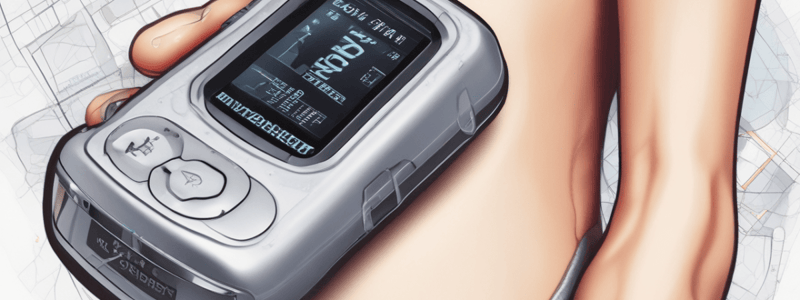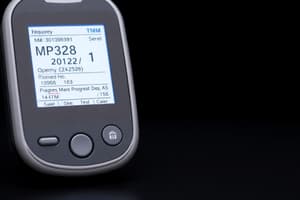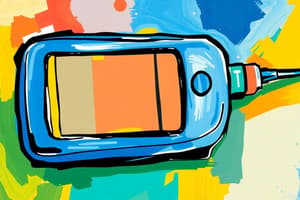Podcast
Questions and Answers
What is the primary benefit of pump therapy in determining the total daily insulin requirement?
What is the primary benefit of pump therapy in determining the total daily insulin requirement?
- It involves establishing the correct basal rate and determining the total basal amount (correct)
- It reduces the need for frequent blood glucose monitoring
- It allows for more insulin to be administered at once
- It eliminates the need for bolus insulin administration
What is the typical daily insulin requirement for an average 70-kilogram adult using pump therapy?
What is the typical daily insulin requirement for an average 70-kilogram adult using pump therapy?
- 35 units of insulin per day
- 42 units of insulin per day (correct)
- 50 units of insulin per day
- 60 units of insulin per day
What is the primary difference between the basal and bolus segments of insulin pump therapy?
What is the primary difference between the basal and bolus segments of insulin pump therapy?
- Basal segment is used for mealtime insulin, while bolus segment is used for correcting high blood sugars
- Basal segment provides a steady trickle of insulin, while bolus segment provides on-demand insulin for meals (correct)
- Basal segment provides on-demand insulin for meals, while bolus segment provides a steady trickle of insulin
- Basal segment is used for correcting high blood sugars, while bolus segment is used for mealtime insulin
Why do experts suggest that pump therapy requires less insulin per kilogram than MDI?
Why do experts suggest that pump therapy requires less insulin per kilogram than MDI?
What is the primary advantage of the customizable nature of insulin pumps?
What is the primary advantage of the customizable nature of insulin pumps?
When was the insulin pump approved by the FDA?
When was the insulin pump approved by the FDA?
What is a potential benefit of using insulin pump therapy compared to injection therapy?
What is a potential benefit of using insulin pump therapy compared to injection therapy?
What is a challenge of determining correct basal rates in insulin pump therapy?
What is a challenge of determining correct basal rates in insulin pump therapy?
What is the purpose of increasing the nighttime basal rate in insulin pump therapy?
What is the purpose of increasing the nighttime basal rate in insulin pump therapy?
What is a potential strategy to solve the problem of insulin delivery deficit in insulin pump therapy?
What is a potential strategy to solve the problem of insulin delivery deficit in insulin pump therapy?
What is the benefit of a 1% reduction in HbA1c levels?
What is the benefit of a 1% reduction in HbA1c levels?
What is a potential benefit of insulin pump therapy in terms of long-term outcomes?
What is a potential benefit of insulin pump therapy in terms of long-term outcomes?
What is a challenge of using insulin pump therapy in patients with unpredictable work hours?
What is a challenge of using insulin pump therapy in patients with unpredictable work hours?
What is the purpose of a real-time continuous glucose monitor in insulin pump therapy?
What is the purpose of a real-time continuous glucose monitor in insulin pump therapy?
What is a potential benefit of increasing insulin concentration and activity during the night?
What is a potential benefit of increasing insulin concentration and activity during the night?
What is the result of a 10-year use of insulin pump therapy compared to MDI therapy in adolescents with type 1 diabetes?
What is the result of a 10-year use of insulin pump therapy compared to MDI therapy in adolescents with type 1 diabetes?
Flashcards are hidden until you start studying
Study Notes
Determining Total Daily Insulin Requirement
- Pump therapy requires less insulin per kilogram than MDI, typically 0.6 to 0.7 units/kg/day for adults.
- An average 70-kilogram adult would require 42 units of insulin per day.
- The total basal requirement is calculated, considering dawn phenomenon or increased insulin resistance in the early morning hours.
Insulin Pump Therapy
- Insulin pumps are wearable devices that connect to narrow, flexible plastic tubing and were FDA-approved in 1983.
- Pumps allow users to deliver a steady trickle or basal amount of insulin continuously throughout the day, providing on-demand insulin for meals and correcting high blood sugars.
Benefits of Insulin Pump Therapy
- Avoidance of severe hypoglycemia
- Improved blood glucose levels and HbA1c outcomes
- Improved lifestyle and greater flexibility
- Improved diabetic ketoacidosis (DKA)
Study Findings
- A 28% reduction in postprandial blood glucose levels with insulin pump therapy compared to Lantus insulin
- Insulin pump therapy reduces HbA1c levels compared to injection therapy in both adults and children
- A 35% reduction in risk of microvascular complications for every percentage point drop in HbA1c levels
- A mean discounted Quality Adjusted Life Year (QALY) gain ranging from 0.70 in adults to 4.27 in adolescents with type 1 diabetes
Challenges and Strategies
- Determining correct basal rates can be challenging due to frequent adjustments or lack of structure in food intake or meal times
- Basal rates may be based on fasting studies or observing blood glucose levels throughout the morning or afternoon
- Increasing the nighttime basal rate can significantly improve fasting glycemic control, reduce hypoglycemic episodes, and not increase hypoglycemia overnight
Studying That Suits You
Use AI to generate personalized quizzes and flashcards to suit your learning preferences.




